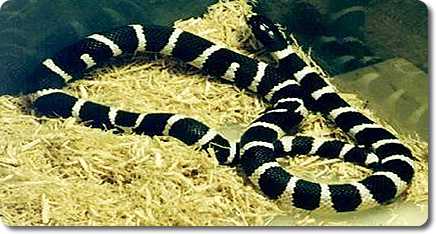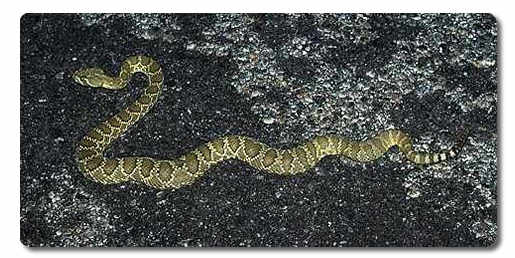
California Kingsnake (Lampropeltis getula californiae)
Introduction to SNAKES |
| | Quick Jump to any Section | |
|
|
|
The popularity of snakes has been rising rapidly for the last few years; a recent study has shown that almost 15 million people in the United States have a snake. This increasing number of dedicated people keeping and studying them have contributed to improving our rudimentary knowledge of snakes. Ever since the story in Genesis 2 of the Bible, this much-slandered creature has become an object of fear and disparagement to man. Since then, there has been the idea that snakes are something dangerous or evil. But why? Most people who feel that way have never even seen a snake in the wild, let alone get harmed by one. It is just a common prejudice usually taught by parents from an early age (excluding people with ophidophobia). So when it is understood that snakes have nothing inherently bad or wrong in them, people will be able to give this marvelous creature the respect that it deserves. Now people, in general, know more about snakes -- though that doesn't stop the animosity that some people still feel. These days, however, I find that much more people (especially kids) tolerate snakes more -- even if they dislike them. |

California Kingsnake (Lampropeltis getula californiae) |
The Classification of SnakesSnakes are in the sub-order Serpentes. They share the order of Squamata with lizards and Amphisbaens (not Amphibians, such as frogs, toads, salamanders). They are in the class Reptilia which includes turtles, crocodilaens (alligators, crocodiles, etc.), and the rare-in-its-own-order, Tuatara. Lizards, though in appearance strikingly different,are the closest relatives to snakes. |
The Physical SnakeSnakes all have similar body shapes, though the girth can vary so much that a 5 foot long Coachwhip snake may weigh less than a pound, while a 5 foot long Eastern Diamondback rattlesnake can weigh up to 6 pounds. Snake also do not vary much in basic body features; characteristics common to all snakes are:
The headCompared to the body, the head is small and very light. Because snakes cannot chew or tear their food, their skull has evolved to stretch and swallow prey much thicker than its own head. Snakes can have up to 200 hundred teeth in their jaws, and they are constantly growing in new teeth as the old ones fall out. Their jaws are suprisingly strong, and they can dislocate the bones in their jaw to fit large prey. The organsThe organs are elongated so that they can fit in a long, cilindrical body. The heart is rather normal compared to some other organs. They have only one fully functional lung; it is one-third the length of the snake. The other is tiny, and in most snakes, useless. The intestines, stomach, and liver are very long and the stomach can expand so that they can eat large prey. The kidneys are small, and lima bean shaped. They have no urinary bladder; instead they excrete through the cloaca, along with solid waste, a pasty yellow substance called uric acid. Almost everything a snake eats is digested. The male snake has two reproductory organs called the hemipenes (pronounced:"hem-e-peens"). The female has a pair of scent glands that during the breeding season release "pheremones". The external snakeSnakes have skin embedded with scales. The scales are made of
keratin, the same substance fingernails are made of. Their eyes
are covered by a clear scale called the brille which protects
their eyes from dust, debris, and injury. The purpose scales
serve is to protect the snake's skin, enable serpentile
locomotion, and minimize water loss. From time to time the snakes
shed the outer layer of their scales. It is a common
misconsception that snakes shed their skin -- they actually only
shed the outer layers of the skin -- since this part is incapable
of growing. They do this by secreting a special fluid between the
layers of the skin. The fluid causes the skin to separate and
soften, the colors of the skin becomes ghostly dull and strangely
opaque, the eyes blue. In a few days the skin and eyes clear up.
A couple of days after that, the snake rubs its snout against
something abrasive and the skin around its head starts to peel.
Then the snake literally crawls out of its skin, turning the dead
layer inside out. |
 Behold, I send you forth as sheep in the midst of wolves: be ye therefore wise as serpents. . . Snake intelligenceIt is unfair to say that snakes are dumb (though they ain't
exactly Edison, they ain't exactly Dan Quayle, either). Although
it is true to say that snakes act mainly through "instinct",
snakes are very perceptive of their enviroment. For instance, a
lot of snakekeepers say when they go to their rattlesnakes, the
snakes act calm and normal. But when other people try to approach
them, they rattle vigoriously and take defensive poses. Although
it's nice to think that snakes have emotions (like joy, anger,
and affection), scientific studies show that snakes just don't
have the cerebral capacity for them. However, snakes do have
"primitive" feelings like aggression, fear, and pleasure. Snakes
are able to learn simple things such as tolerating handling,
eating an unnatural food item, and of course, adapting to
captivity. But to teach a snake to learn things like to "fetch"
(like a dog can), or "sit-stay" (I saw a 11 year old telling his
rosy boa to stay and be a good little snake) is not relevant to
snakes.
Home
| Snake Basics |
Snake Basics 2 |
Snake Quiz |
My Snakes |
Snake Care
Conservation | Giant Snakes | About the Authors | Cool Links |